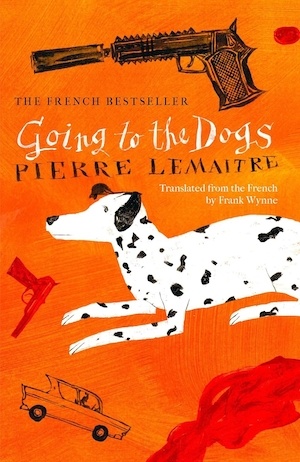
Translated by Frank Wynne — Crime Fiction Lovers already recognise that Pierre Lemaitre is a master of the thriller whose books can be hard, unsettling and downright violent at times – such as his Camille Verhoeven novels. So don’t be fooled by the cosy-style cover of his latest novel. Lemaitre has not gone soft and Going to the Dogs has both the bark and the bite of its predecessors.
Set in Paris in 1985, this standalone follows Mathilde Perrin, a seasoned contract killer who, at the age of 63, is a threat to anyone her clients want dead… and their dogs too, for that matter. Until recently, Mathilde’s success rate was 100 per cent. She gets the job done without any glitches or glimmer of conscience. The older she gets, the more invisible she becomes, turning her into the perfect assassin.
But lately, Mathilde has been forgetting things, including to get rid of murder weapons. Over the past 30 years, she has tossed guns off most of Paris’ bridges, but these days she finds them lying about the house instead. More than that, she is becoming agitated, impulsive and completely unhinged.
When tasked with assassinating a French business tycoon on the street outside his Paris house, she deviates from her modus operandi and, on a whim, shoots him in the groin, then in the throat, which decapitates him. She also shoots his barking Dachshund just for the hell of it. This is a good time to point out that Going to the Dogs might not be ideal for animal lovers.
But, back to our story. Keeping murder weapons isn’t Mathilde’s only problem. When she comes across a note with a woman’s name on it she wrongly assumes this is her next target. Shortly after she kills a young woman in the same way and with the same gun, as the business tycoon, her superior, Henrie, has no choice but to intervene. The authorities have established a link between the murders and Mathilda’s car was spotted near both murder scenes. But who would suspect the frumpy, overweight, old lady?
Henri Latournelle, alias The Commandant, has known Mathilde since they were in the Resistance. Even at 19 she was cruel and cold blooded. Described as “at once ghost and muse, saint and succubus, goddess and demon” Mathilde terrified and captivated Henri in equal measure. But Mathilde won’t let Henri nor René Vasiliev, the detective from the police judiciaire, stand in her way.
Vasiliev is one of just three likeable characters in Lemaitre’s story – another is Mathilde’s Dalmatian, Ludo. At the very least, Vasiliev is not racist or sexist. Unlike his petty, two-faced, nut-guzzling superior Commissaire Occhipinti. Occhipinti assigns Vasiliev the cases he dislikes the most, and as a result, he has become a specialist in sexual assault and murder. When the detective is not subsisting on tinned food, he eats his dinners with Tevy, the carer for Monsieur de la Hosseray’s, who in turn was the employer of Vasiliev’s father and who helped pay for Vasiliev’s education. Tevy, the third likeable character in the book, has begun to become the main reason for his visits rather than Monsieur de la Hosseray.
With a contract killer who is an old woman, Going to the Dogs is reminiscent of The Old Woman With the Knife by Gu Byeong-Mo. A character like this can elicit our sympathy in spite of their profession, but this isn’t the case for Mathilde. After brutally killing a man her expression is “a curious mixture of amazement and pleasure. Like that of a chubby little boy who had just discovered a rare insect.” Mathilde is merciless, hateful and intolerant of different races and sexual orientations, even her own daughter. She frequently contemplates how she can dispose of her inquisitive neighbour, Monsieur Lepotevin.
Apart from these challenging personality traits, Lemaitre makes it clear that Mathilde is overweight and unattractive. Hardly a few pages pass without distasteful references to her appearance, making it difficult not to conclude that Lemaitre hates overweight women. Mathilde may not be a sexy, female Bond assassin, but we can do without the needless fat shaming.
There is some dark humour, but not nearly enough to counteract the much darker, violent and scathing undercurrent. Perhaps this novel is Pierre Lemaitre’s attempt to poke fun at those light-hearted mysteries involving elderly protagonists by the likes of Richard Osman? Going to the Dogs is likely to appeal to followers of Lemaitre, especially because it may be his final farewell to the crime fiction genre. If you’re easily offended or adore dogs, it may not be for you.
Headline
Print/Kindle/iBook
£11.99
CFL Rating: 3 Stars







